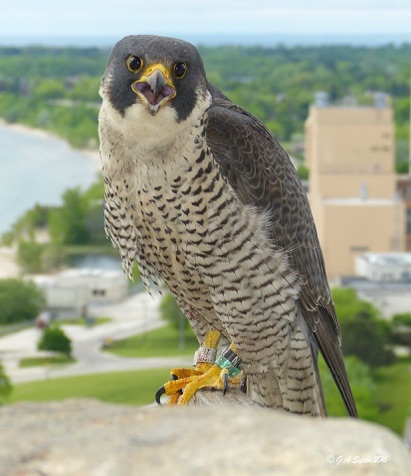Wisconsin Falconwatch
All Content © Greg Septon 1987-2019
Wisconsin Falconwatch
All Content © Greg Septon 1987-2019
Peregrine Falcons in Wisconsin
© Greg Septon 2019
The historical (pre-DDT) population of peregrines in Wisconsin probably numbered from 24-30 nesting pairs that occupied cliff eyries along the Mississippi and Wisconsin Rivers and along the Door peninsula.
Peregrine falcons began suffering tremendous population declines in North America and elsewhere beginning shortly after WWII. The culprit was the agricultural, chemical pesticide DDT which sprayed on crops to control insect pests worked it’s way up the food chain causing falcons to lay thin-shelled eggs which often broke during incubation.
By 1964, the peregrine falcon was extinct east of the Mississippi River and the remaining population in the western US drastically reduced. In 1970 the peregrine was added to the federal list of endangered species and in 1972 the use of DDT was banned in the US after which a concerted and broad effort was undertaken to restore the species across North America.
The peregrine falcon recovery program in Wisconsin began in 1987 with the release of 14 captive-produced young falcons from atop the First Wisconsin Center in Milwaukee - the state’s tallest building. Additional urban releases of captive-produced young were carried out between 1988-1992 at: Racine, Pleasant Prairie, Madison & La Crosse. The total number of captive-produced young peregrines released in WI is 103.
In 1988 the first successful nest was recorded in Milwaukee when two peregrines occupied the original hack (release) box atop the First Wisconsin Center producing two young. This was the first successful peregrine nest in the state in over 20 years. With a concerted effort (The Lakefront Plan) to install nest boxes on suitable, tall, human-built structures (tall buildings, power plant stacks, grain elevators, etc.), one by one the nest boxes became occupied and the peregrine population slowly began to recover in the state.
By 2019 we had a known total of 37 successful nests in the state that produced a total of 110 young. Of the 37 successful nests, only 7 were on historical cliffs with 6 along the Mississippi River and 1 at Rock Island which shows just how important the urban nest sites remain.
With continued environmental stewardship by corporations that offer support and provide and maintain nest boxes at their sites, the future of peregrines in Wisconsin will remain bright.

Below are downloadable PDF copies of annual nesting reports for Peregrine Falcons in Wisconsin. We’re currently working on assembling the early reports from 1987-1995 and will include these as they are completed.
Above: “Valcor” (b/g) N/22, a female peregrine produced in 2013 at Chicago’s Wrigley nest site in Chicago, IL. She nested at the Briess Malt site in Manitowoc, WI in 2016 - 2018 producing 4 young each year.